Neil Taylor, Strike Three Kayak Fishing
Choices in lines are like so many other things in this world: There are almost too many choices to sort through. The people who really get out there and try everything out, they have great input. Mono versus braid; mono versus fluorocarbon; all comparisons- you can find what works best for you. Over the years I have compiled a lot of input. I will include my own choices and why. Get what works best for you. I have my own reasons for everything I use, lines included.
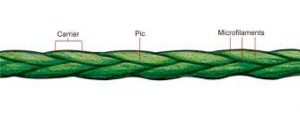 The braid advantage: Hanging up on seagrass, the slight flick of the wrist and it’s out of the snag. Compare it to monofilament or even fluorocarbon and you may almost have to pull to breaking strength or get closer to where it is lodged to get it out. This is a saltwater advantage. I know freshwater guys with no interest in braided line. But I know very few saltwater people who don’t use braid.
The braid advantage: Hanging up on seagrass, the slight flick of the wrist and it’s out of the snag. Compare it to monofilament or even fluorocarbon and you may almost have to pull to breaking strength or get closer to where it is lodged to get it out. This is a saltwater advantage. I know freshwater guys with no interest in braided line. But I know very few saltwater people who don’t use braid.
A Daiwa product, high end: 15 pound Samurai is so fine that it will take hundreds of yards to fill a single spool. It doesn’t tangle as much as other lines and having that much line enables you to do battle with fish that can take out a lot of line.
Fluorocarbon as a main line?
Four and six pound Seaguar InvizX lines are perfect for speckled trout rods. It is a step up over mono and does make a quality main line. It finishes second place behind my 15 pound braid. Less “memory” than monofilament, it is a better overall choice than mono.
“I’ve heard the Suffix is good but I’ve never used it. I am sponsored by Power Pro and I use 15# on pretty much everything I have. I’m very happy with it and I don’t have any reason to change. Before that deal I had gotten a bulk spool of the Tuff Line and I thought it was good too.” I fit that same category, with Power Pro at the beginning of my guiding career, they made some changes and I found myself without a line sponsor. Before long I landed with Tuf Line and have been with them ever since.
I thought the Tuff Line had fewer problems than other types of line I’d tried before that but I think what really happened was I just had a lot more experience with braided line. With experience comes a great deal fewer knotty problems with any of these line you use. The line was priced out a little cheaper than nearly all other options, not that it matters to me because they supply me with enough line every year to spool up 30 reels.
Other radio show hosts use “Fins” braided line. Just as there are other quality rod and reel manufacturers, there are multiple sources for great line. Jason does well with Fins. I used it when Captain Mel Berman gave me some years ago. It was good.
For you and your braided line. The only real “damaged” line should be near your lure or terminal tackle/leader. Just line that looks a little worn doesn’t necessarily mean it is weak. I’ve had reels with spools of braid on them that has lasted for several years. It’s that durable.
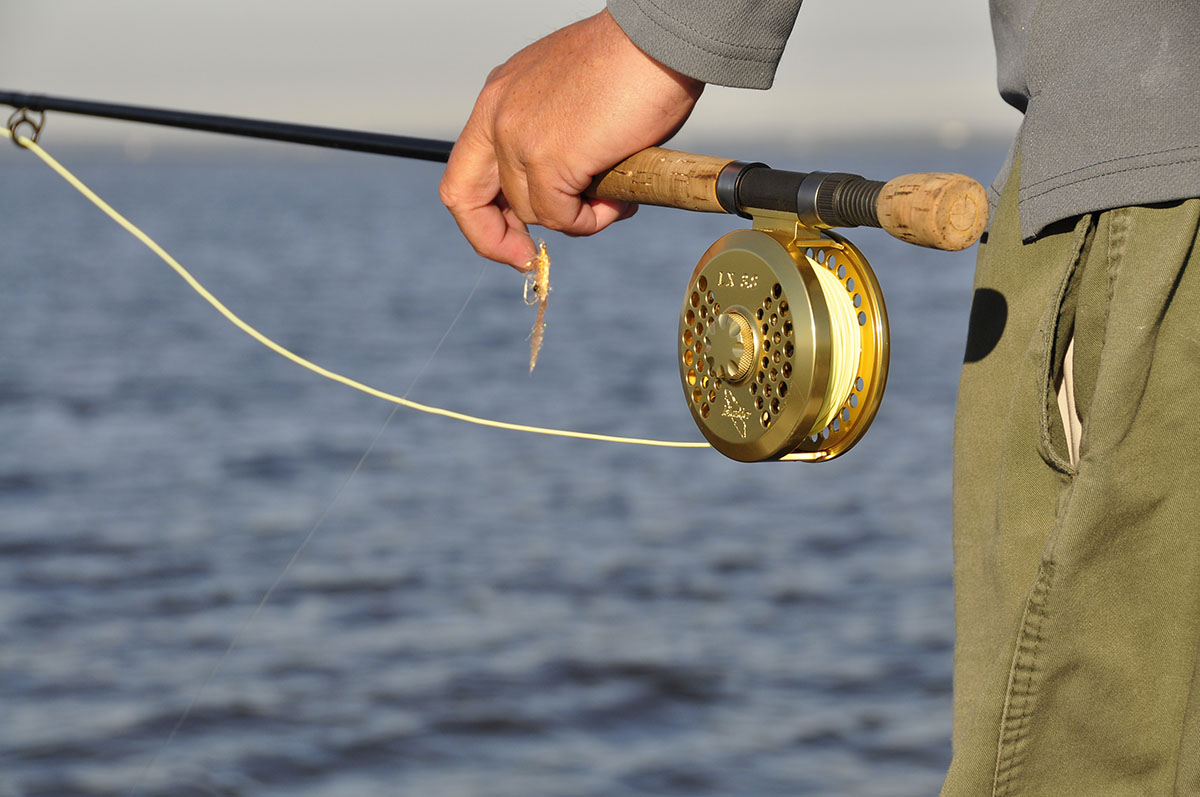 I know a lot of the folks who fish in freshwater or in cold climates use the mono instead of the braided line. There are a number of options for braided line. I use braided line 99% of the time. When do I not use it? One big one is when I have a kid under the age of 12. Casting knots can be a nightmare. They get in a lot less trouble with monofilament than braid.
I know a lot of the folks who fish in freshwater or in cold climates use the mono instead of the braided line. There are a number of options for braided line. I use braided line 99% of the time. When do I not use it? One big one is when I have a kid under the age of 12. Casting knots can be a nightmare. They get in a lot less trouble with monofilament than braid.
“I used mono for a very long time. Now, except for fishing for speckled trout on light tackle, I won’t ever use it. Once you get used to that positive hook set you get from the zero stretch of the braided line, it’s tough to go back. With trout, that little “give” that mono has is something that is actually a benefit to catching trout. The speckled trout has big fang teeth up front that they use to squeeze down on and kill their prey. They will often grip a lure below the jig hook and that little extra stretch can lead to more hookups as they adjust to finish eating their meal. “
The only real “damaged” line should be near your lure or terminal tackle/leader. Just line that looks a little worn doesn’t necessarily mean it is weak. I’ve had reels with spools of braid on them that has lasted for several years. It’s that durable. Damaged line will still work. It may fail under high stress but not with light action.
If you have the spare spools, you can bury the exposed/worn line by switching out spools and running the line onto the new spool off the old one, bringing the less weathered line out from under the first spool and putting it into use with the line that’s been hidden under the other line on the original spool. The trick: Knowing how much backing to utilize. You want optimal spooling of your reels for casting. Reversing line off one spool onto another requires some guesswork.
I think there is a huge difference between faded and damaged. Absolutely, remove line that’s dinged up. I trust faded line just fine. Compromised line has risks but I’ve seen large fish caught on line that is not perfect.
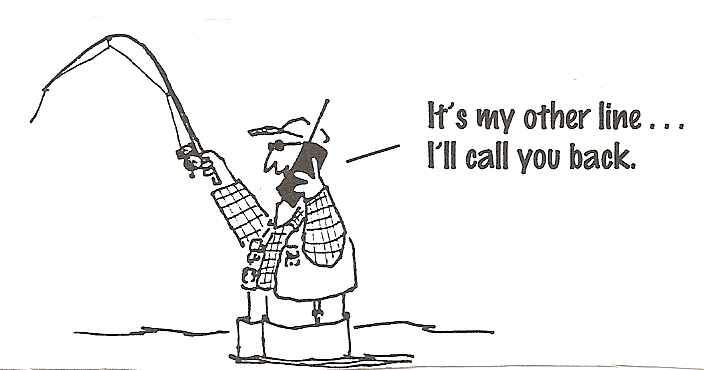 General Thoughts:
General Thoughts:
Casts off to the side are another culprit of the wind knot
Twist/Untwist- The knots you get will usually come out “what braid hath twist, will untwist again.” If the issue involves a leader, clip the leader line off for a faster resolution to this tangle.
Lighter lures, take the extra time to give the line a tug against the spool after each cast
Closing the bail manually after a cast will reduce problems with casting knots.
The quality of your reel is also a large part of the equation…don’t skimp on reels, Reel quality can dictate the Quality of your time fishing.
Trying to make that extra long cast? If your line isn’t tight to that spool, this could be when it stacks up on your blank. Better to make long casts without that extra exertion. You get your lure out there a good distance but don’t have the frustration of a casting knot.
New Concept guide systems minimize tangles. These are smaller guides and better line control.
Line stretch and memory equals twisted line and replacing mono after several large fish are caught.
Zero stretch equals more solid hooksets. I remember this from my mono days: I used to set the hook harder, unnecessary with braided lines.
Problems with monofilament
Without question with mono if you’re catching big fish, the line memory is going to make it where you will have to change the line regularly. I call the memory problem “the twisties”. It stretches with that strain of a large fish pulling and pretty soon when casting you’ll notice that the line right by your leader is twisting. So you trim some off. After this happens a few times, your spool is getting lower and it is affecting your casting distance.
I haven’t found anything that scientifically supports it. My experiences make me believe that there is a distinct difference between the spinning spool that is not taking any line in and super-stretched mono from a fight that has the line really under strain. But perhaps it is a combination of both. Often answers lie in the middle somewhere. A properly set drag on a large fish may be spinning a little while line is being retrieved even if you do know not to crank with the spool spinning.
If the problem is with the cranking against the drag then why wouldn’t the twisties be on line that’s toward the middle of the spool?
The twisties after battle I’m talking about are right by the terminal tackle/lure. Sometimes it’s five feet of line you sacrifice, sometimes ten. That happens a few times and now you’re having trouble with casting distance.
Heavier mono, people probably wouldn’t notice it as much. I have used 6 to 10 pound lines that were quality lines and I was happy with the day when braided lines came out. You may not believe this, but I’ve caught a lot of big fish (really, I have). And with the action I would be on I knew that the mono I had on my medium spinning outfits was likely only going to last a few weeks tops. But braided line? I have had spools that had braided line that lasted several years with heavy use. Was I fishing around a lot of rocks? No. Oysters, yes but the way I’ll use lures, the only line that will ever touch an oyster is the leader line.
It’s just my thoughts on it. It’s not to say I’m right and anyone else is wrong but since I was someone who suffered from The Twisties and I knew I wasn’t “reeling against that noise” but putting some heat to a fish: I think that it’s line memory and maximum stretch that causes it.
Without question with mono if you’re catching big fish, the line memory is going to make it where you will have to change the line regularly. I call the memory problem “the twisties”. It stretches with that strain of a large fish pulling and pretty soon when casting you’ll notice that the line right by your leader is twisting. So you trim some off. After this happens a few times, your spool is getting lower and it is affecting your casting distance.
Knots and problems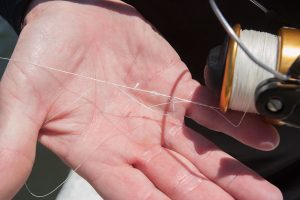
Wind knots are what I call “casting knots.” Most prevalent with people who are casting light lures or baits that are also light, there are reasons for this to happen like Captain John said. When the line is originally wound on the spool, it is tight on there. With use, particularly with really light lures, the line will be wound on the spool looser, putting the line so much closer (in some cases, almost spilling over the rim) of the spool.
Slack on the spool, which can be the result of cranking the handle to close the bail on the spinning reel instead of manually closing the bail, can cause the line to slap the blank on a cast. That temporary interruption of the line going through the guides causes it to pile up and “twist”. A simple one, the line will continue through the guides and it’s a small tangle. A larger one the line will stop on one of the guides while line continues to come out of the spool, creating a mess.
Anyone else notice that they get the knots when trying to add that extra couple of yards to your cast? Keep your casting technique smooth all the time and it should happen less often. That extra hard snap and the bounce of the rod increases the chances of a tangle occurring in the braided line.
Puzzles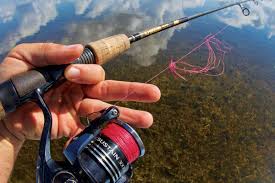
Braided line twists, but it also untwists. The biggest key is to not pull anything tightly together. In putting it away to deal with it later, there is another benefit. I would rather deal with these knots with the line dry, as well as my hands.
I’m a big believer that any knot that occurs with these lines can be worked out. I call it “twist, untwist”. As long as you don’t pull the different loops too tightly together, any of these knots can be worked out. Pat Rice and Dunedin Fishing Center laughs at me working out these knots in his parking lot and says “just cut it!” Before I sold off a lot of used reels recently I was looking and I think there were a couple of those spools that had been in use for over two years.
I’ll set aside a rod and do the untangling after a trip. I do carry spare spools to switch out a spool that blows up with a big problem like that. I do like “clean spools” of line, not reels that have a bunch of splice points in it.
A very useful tool is a little hand took that has a pointing “hook” on it that you can use to loosen up the tangles in those really problematic areas. I’ll see if I can find a photo of the one I have and post it. It’s something that might be useful for people to carry along with them.
Here it is. It’s similar to the one I have. This one was called a “scriber”. Something like this is fantastic for helping with those knots.
Consider your options, try different things. Get good line on your rods and enjoy your fishing! Nothing replaces good technique: Smooth casters will have the fewest problems.
Neil Taylor
Owner and guide: www.strikethreekayakfishing.com
(Cell) 727-692-6345 LivelyBaits@aol.com
Owner and site administrator: www.capmel.com
- The Neil Blog… - July 26, 2023
- The Catfish - July 26, 2023
- update - July 22, 2023











